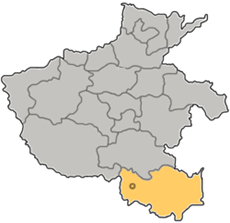Top Qs
Timeline
Chat
Perspective
Xinyang
Prefecture-level city in Henan, People's Republic of China From Wikipedia, the free encyclopedia
Remove ads
Xinyang (simplified Chinese: 信阳; traditional Chinese: 信陽; pinyin: Xìnyáng; postal: Sinyang) is a prefecture-level city in southeastern Henan province, People's Republic of China, the southernmost administrative division in the province. Its total population was 6,234,401 according to the 2020 census. As of the 2010 census, 1,230,042 of them lived in the built-up (or metro) area made of two urban districts, Pingqiao and Shihe.
Remove ads
History
As early as over 8,000 years ago, Neolithic cultures began primitive agriculture of considerable scale along the Huai River, such as the Peiligang, Longshan and Qujialing cultures.
During the Great Leap Forward, one million farmers died in what was known as the Xinyang Incident.[6]
Geography
Summarize
Perspective



Geography of city
The prefecture-level city of Xinyang has a total land area of 18,819 square kilometres (7,266 sq mi). The city is located in the southernmost part of Henan Province on the south bank of the Huai River and in the middle of the Dabie Mountains area. It borders the cities Zhumadian to the north and Nanyang to the northwest, and the provinces of Anhui and Hubei to the east and south respectively. The region where Xinyang is located is considered a subtropical area and the Dabie mountainous terrain is mainly to the north, south, and east of the city.
Climate
Xinyang has a monsoon-influenced, four-season distinct humid subtropical climate (Köppen Cfa/Cwa), with cold, damp winters, and hot, humid summers. The months of April through June here are slightly cooler than much of the rest of the province. The monthly 24-hour average temperature ranges from 2.4 °C (36.3 °F) in January to 27.3 °C (81.1 °F) in July; the annual mean is 15.54 °C (60.0 °F). The annual precipitation is just above 1,100 millimetres (43 in), and close to two-thirds of it occurs from May to September. With monthly percent possible sunshine ranging from 38% in March to 47% in four months, the city receives 1,974 hours of bright sunshine annually; January through March are the cloudiest months.
Remove ads
Administration
The Xinyang City is further divided into two districts and eight counties.
Xinyang City has 2 districts and 8 counties, including Shihe District, Pingqiao District, Huangchuan County, Guangshan County, Xi County, Xin County, Luoshan County, Shangcheng County, Huaibin County, and Gushi County.[10]
Demographics
According to the Seventh National Census in 2020, the city's Permanent Population (hukou) was 6,234,401.[11]Compared with 6,108,683 people in the Sixth National Census in 2010, the number increased by 125,718, representing a growth of 2.06%, with an average annual growth rate of 0.20%.[11]
According to the 2010 Census, the population of Xinyang is of 6,109,106 inhabitants, 6.39% less than the population marked on the last census of 2000, when there were 6,527,368 inhabitants in the city.[12]
Its built-up area is home to 1,230,042 inhabitants spread out on 2 urban districts and 3,665.9 square kilometres (1,415.4 sq mi).
Remove ads
Culture


Xinyang Tea Culture Festival is held during April 28 and 30 of every year. The 25,000-capacity Xinyang Stadium, which has a capacity of 25,000, is located in the city. It is used mostly for association football and sometimes for athletics.

The Jingju Temple in Guangshan county was the source of the first Chinese section of the Buddhist "Tiantai school" as early as the fifth year of Tianbao in the Northern Qi Dynasty (554 A.D.),[13] since the saint monk Huisi came to the Jingju Temple. Emperor Shenzong of Song bestowed the "Emperor entitled Brahma Temple" still conserved in the temple.[14]
Remove ads
Transportation
- Highway system
- Railway system
- Airport
Education
- Higher Education
- Secondary Education
- Xinyang Senior High School
- Guangshan Second High School
Recreation
Twin towns
See also
References
External links
Wikiwand - on
Seamless Wikipedia browsing. On steroids.
Remove ads





